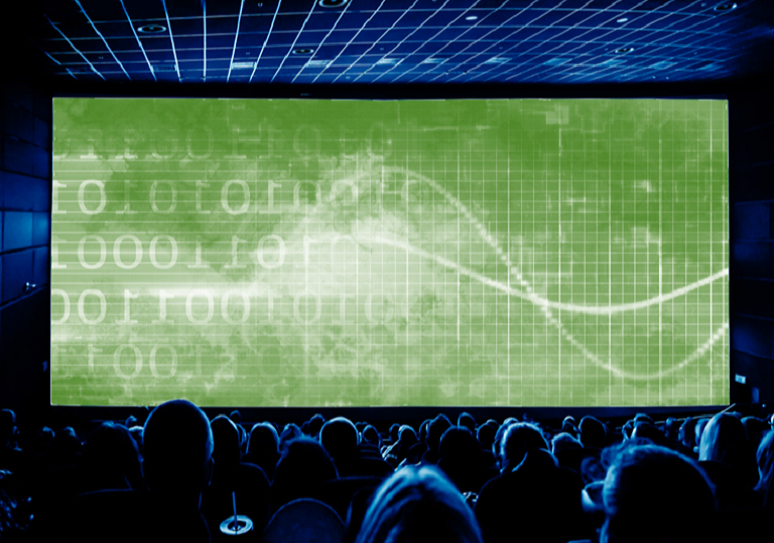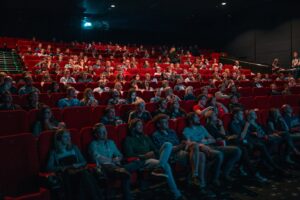By Henrik Axelsson
 Norwalk, Conn., May 2, 2023–It is only over the last 20 or so years that the movie industry has made the switch to digital, foregoing costly and cumbersome celluloid reels and hard drives for digitally projected films. In that time, the way that those movies files are distributed has advanced dramatically.
Norwalk, Conn., May 2, 2023–It is only over the last 20 or so years that the movie industry has made the switch to digital, foregoing costly and cumbersome celluloid reels and hard drives for digitally projected films. In that time, the way that those movies files are distributed has advanced dramatically.
Today, content distribution networks – whether distributing independent releases or global blockbusters – have several options to ensure their digital files arrive at the theater in one piece. Satellite has established itself as the most efficient and cost-effective option, but for assured, faultless and reliable delivery, it needs to be accompanied by technology that is smart enough to resolve transmission errors.
Reeling Back the Costs
Aside from the cost – an average of US$ 2,000 per print – the celluloid reels that dominated much of the 20th century were flammable and posed a safety risk. Safer magnetic tapes were introduced but they too required time and effort for production and distribution. The motion picture industry began converting to all-digital at the start of the 21st century. Now, virtually all of the world’s 200,000 screens are digital.
Today, those screens typically show movies that have been sent digitally. This can be done by sending a hard disk drive to the theater with the movie or, assuming “last mile” fiber links are in place, by transmitting the movie file over an internet network. This avoids the time and cost required to physically ship hard drives but does requires a reliable, high-bandwidth network to be successful.
Terrestrial delivery networks like a CDN (Content Delivery Network) networks are one option. Yet as soon as cinema networks expand beyond around 400 theaters, it becomes incredibly cost-ineffective and rapidly more expensive as more locations are added. The graph below illustrates the rising cost typical of a CDN network as the network grows:

Moreover, in emerging markets, regions with unforgiving terrain or economic barriers to deploying terrestrial networks, it becomes an even less feasible option. In some large markets that still do not have reliable and widely available terrestrial connectivity, Quality of Service (QoS) can be hard to guarantee, especially for live events.
Fortunately, there is a great alternative. Satellite has occasionally been considered as an expensive technology to cover the areas where terrestrial networks do not exist. However, that perception overlooks satellites’s tremendous utility. Satellite connectivity can achieve very high bandwidth and data rates plus built-in redundancy makes such networks dependable, delivering constant connectivity. Satellite can be deployed without the same degree of capital expenditure that a terrestrial network will often demand. Operating expenditure is typically lower too and, perhaps most importantly, it is highly scalable.
In fact, Howard Kiedaisch, the CEO of Digital Cinema Distribution Coalition (DCDC), which was founded by the heads of leading U.S. studios and exhibitors – including AMC Theatres, Cinemark Theatres, Regal Entertainment Group, Universal Pictures, and Warner Bros – recently remarked, “Though there is a lot of excitement about broadband solutions and talk of satellite distribution being an antiquated technology, it’s by far the most cost effective and reliable method to transmit our content at this time.”
Essentially, the cost doesn’t change depending on whether you’re reaching a few hundred to thousands of viewers with your movies.
Seamless Delivery Solutions
Satellite multicasting, from point to multiple points, is unparalleled in its ability to simultaneously reach a nearly unlimited number of geographically dispersed sites. It is not error-proof, however, as digitally transmitted files are always prone to delay, degradation and deletion. The likelihood of error increases significantly the larger the size of the file. Although the average film file size is about 250 gigabytes, there are many films over 1 terabyte. An incomplete or damaged file is unusable to cinema networks and content distributors who are dependent on assured, faultless delivery of their content.
To solve such errors on the fly, a mathematical concept utilizing algorithms to correct for errors was developed. Although the math is complicated, the concept known as Forward Error Correction (FEC) is simple. It is possible to think of FEC like a Sudoku puzzle where if a user receives enough numbers, they can work out what is missing ones are. If an algorithm can solve for all the missing pieces, it can complete the entire file or stream. However, not all FEC operates in the same way and not all FEC technologies are equal. If you are a leading distributor of films to cinemas and want to stop sending content out on bulky hard drives and start sending with satellite multi-casting, the highest quality FEC will ensure the most reliable delivery of files the first time they are sent – despite errors that may have occurred during transmissions!
The better the algorithm, the higher the efficiency of error correction, the greater the reliability of delivery, the faster the speed for a complete transmission and the larger the cost savings on retransmissions. It is important to know which level of FEC your network uses.
Lights, Camera, FEC in Action
Apart from world-class FEC, custom workflows and functionality must be added to any digital cinema ecosystem to address the requirements of content distributors, including sending, scheduling, encryption, bandwidth and other delivery services. At the transmitting site, FEC and a sophisticated Content Management System monitors and actively optimizes network performance. At the theaterre side, a sophisticated appliance with specialized receive software resides in the projection booth with ample storage to accumulate dozens of films for playout. If the theater is interested in playing live sports, music or other events, a decoding device is needed to uncompress encoded or compressed video audio streams.
When all this comes together, a fully optimized digital cinema network can deliver theatrical content to thousands of theaters to millions of satisfied film goers. In the US, DCDC was tasked with finding such a solution. In 2012, it chose KenCast as their technology partner and, over a decade later, its leading technology supports DCDC’s delivery of feature, promotional, pre-show and live content distribution into theaters throughout the network of 33,000 screens in over 3,000 cinemas.
In the Americas, from the tip of South America to Alaska, KenCast’s digital cinema solution, which caters to hybrid satellite-terrestrial networks, is installed in over 5,000 theaters. It also supports the fastest growing segment in cinema, live content such as sports, concerts and more.
As the digitization of cinema continues and file sizes grow through increasingly higher resolution standards, it’s imperative for content distributors to ensure that their distribution methods harness the most advanced technologies on the market. Field tested proven solutions allow exhibitors to focus on cultivating memorable experience for fans and provide operators invaluable peace of mind.
Despite a perception as a poorer performing and more costly alternative to terrestrial, when scaling a network for live events and feature film releases, it is clear that satellite is far more cost effective and offers superlative performance for many cinema networks.
——————————————-
 Dr. Henrik Axelsson is the President of KenCast. Since joining KenCast in 2006, Henrik has held multiple roles within the company, including software development, operations, business development and management. As President, Henrik oversees the company’s technology roadmaps, its daily operations as well as its marketing, business development and sales initiatives. In concert with the Board of DireB
Dr. Henrik Axelsson is the President of KenCast. Since joining KenCast in 2006, Henrik has held multiple roles within the company, including software development, operations, business development and management. As President, Henrik oversees the company’s technology roadmaps, its daily operations as well as its marketing, business development and sales initiatives. In concert with the Board of DireB



